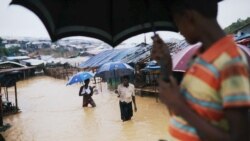Rohingya Broadcast Rohingya “Lifeline” radio - Thursday, July 30, 2020 MC & News: Sami Ahmed, Hamid Hussain & Mohammed Hussain \\arsenic\netexchange$\Bangla\MP3 ROH Lifeline 07302020 1130 UTC Intro Today: Thursday, July 30, 2020 7:30 a.m. (Washington, D.C., USA) News Headlines Duration: 6 minutes · Bereaved Rakhine Families Attest to Rise in Deaths in Myanmar Army Custody (with actuality) · Rohingya are still far from being repatriation process (with actuality) · The Government of Bangladesh has taken a major human rights step to provide shelter to the Rohingya people. · The journey begins:1,000 pilgrims arrive in Mina for first day of Hajj · Taliban announce three-day ceasefire in Afghanistan for Eid al-Adha, starting Friday Shortwave: 31-meter band, 9350 kHz; 25-meter band, 11700 kHz and 12030 kHz Medium wave (AM): 1575 kHz Report: VOA News Related item code: 9-P Duration: 7:30 minutes Translator: Mohammed Idris Abdullah. (Cox’s Bazar) Topic: COVID-19 is hitting Rohingya Muslims in the world's biggest refugee camp, and humanitarian groups are fearing mass infection. Sources: https://mail.google.com/mail/u/0/#inbox/FMfcgxwJWrjWPRKCpnmvNgSKptxqbkDr Summary: Nearly 1 million people live in the largest refugee camp on Earth, the Kutupalong camp in southern Bangladesh. And with a population density greater than that of Manhattan, the Rohingya refugee camps at Cox's Bazar are the ideal breeding ground for a coronavirus which thrives in crowded areas with poor sanitation. "We are getting lots of patients. In this area it is difficult to manage cases with home isolation or quarantine due to the crowded living conditions," said Debashish Chakraborty Debu, coordinator of the HOPE Field Hospital isolation center. The refugees are entirely reliant upon aid for their day-to-day survival. And living conditions are dire. Homes are cramped and often built from flimsy materials while toilets and washing facilities are shared. "This house is 18 feet by 12, with 10 of us in this tiny place. We're having a really hard time," said Mohammed Osman, a Rohingya refugee, sitting alongside his wife and children. Over 700,000 fled into neighboring Bangladesh in the months that followed, having lost everything. "We came because the Myanmar people burned our homes and shot us," refugee Majuma Khatun, told Business Insider Today. "So to save our lives we went to the mountains. We walked through the mountains all night. Then we crossed the river by boat, that's how we came to Bangladesh." With the refugees away from their homes and traumatized by what the UN refers to as a campaign of "ethnic cleansing," the coronavirus is only making an already dire situation worse. "With monsoon, with soil erosion, with flooding, it's a very very difficult environment to be in," said Louise Donovan, Communications Officer for the UN High Commissioner for Refugees. "The camps are hugely overpopulated. You have more than 40,000 people living per square kilometer. And with the risk of transmission of COVID-19, it just makes life so very difficult for this population." The World Food Programme provides food for every refugee in the camps, but lockdown restrictions mean the group has to restrict the number of times people can visit their distribution points. "Just the idea of social distancing is almost impossible to imagine," said Alex Dattani, a Field Operations Consultant for the World Food Programme. "The refugees are scared, they're frightened, they're afraid." The first case was detected on May 14, with the first death coming at the end of the month. As of July 12, there were 57 confirmed cases within the refugee camps and five deaths, according to World Health Organisation figures. Report: Sabera Begum (Cox’s Bazar) Related item code: 9-P Duration: 7:51 minutes Topic: Preparations for the celebration of Eid-ul-Adha (Qurbani) in the world's largest refugee camp in the Coronavirus situat
খন্ড
-
![]() জানুয়ারী ১৬, ২০২৬
জানুয়ারী ১৬, ২০২৬Rohingya Broadcast
-
![]() জানুয়ারী ১৫, ২০২৬
জানুয়ারী ১৫, ২০২৬Rohingya Broadcast
-
![]() জানুয়ারী ১৪, ২০২৬
জানুয়ারী ১৪, ২০২৬Rohingya Broadcast
-
![]() জানুয়ারী ১৩, ২০২৬
জানুয়ারী ১৩, ২০২৬Rohingya Broadcast
-
![]() জানুয়ারী ১২, ২০২৬
জানুয়ারী ১২, ২০২৬Rohingya Broadcast
-
![]() জানুয়ারী ০৯, ২০২৬
জানুয়ারী ০৯, ২০২৬Rohingya Broadcast







